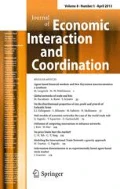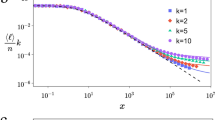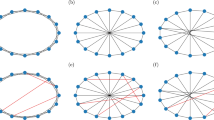Abstract
In this paper, we consider the problem of assessing the “level of small-worldness” of a graph and of detecting small-worldness features in real networks. After discussing the limitations of classical approaches, based on the computation of network indicators, we propose a new procedure, which involves the comparison of network structures at different “observation scales”. This allows small-world features to be caught, even if “hidden” deeply into the network structure. Applications of the procedure to both simulated and real data show the effectiveness of the proposal, also in distinguishing between different small-world models and in detecting emerging small-worldness in dynamical networks.













Similar content being viewed by others
Notes
By “possibly strategic” we refer to changes that may impact on the functioning of the system represented by the network; typically, this is connected to the way information flow across small-world networks (Braha 2004; Costa and Barros 2006), affecting agents’ behavior and potentially leading to systemic modifications and macroscopic effects (e.g. see Uzzi et al. 2007, p. 81, on firm performance in the area of patenting rates).
This inconsistency is less evident in Walsh (1999), as the author associates the small-worldness with \(\mu \) much larger than 1.
We select this interval of probability values, since in this case the networks usually display small-world characteristics.
\(\bar{C}\) assumes values between 0.36 and 0.29 over the time period.
Similar values are obtained by computing the proximity ratio \(\mu \) proposed in Walsh (1999).
In other words, we assure that the number of rewired edges in the WS model is equal to the number of links added in the NW model.
References
Adamic LA (1999) The small world web. In: Abiteboul S, Vercoustre AM (eds) Research and advanced technology for digital libraries. ECDL 1999. Lecture Notes in Computer Science, vol 1696. Springer, Berlin, Heidelberg
Andrade RFS, Miranda JGV, Pinho STR, Petit Lobão T (2008) Measuring distances between complex networks. Phys Lett A 372(32):5265–5269
Axenovich M, Kézdy A, Martin R (2008) On the editing distance of graphs. J Graph Theory 58(2):123–138
Barmpoutis D, Murray RM (2010) Networks with the smallest average distance and the largest average clustering. arXiv:1007.4031
Barrat A, Weigt M (2000) On the properties of small-world network models. Eur Phys J B 13:547–560
Barthélemy M, Amaral LAN (1999) Small-World networks: evidence for a crossover picture. Phys Rev Lett 82(15):3180–3183
Battiston S, Catanzaro M (2004) Statistical properties of board and director networks. Eur Phys J B 38:345–352
Bellenzier L, Grassi R (2014) Interlocking directorates in Italy: persistent links in network dynamics. J Econ Interact Coord 9(2):183–202
Bertoni F, Randone P (2006) The small-world of Italian finance: ownership interconnections and board interlocks amongst Italian listed companies. SSRN Electron J. doi:10.2139/ssrn.917587
Braha D (2004) Information flow structure in large-scale product development organizational networks. J Inf Technol 19(4):244–253
Braha D, Bar-Yam Y (2006) From centrality to temporary fame:dynamic centrality in complex networks. Complexity 12(2):59–63
Caldarelli G, Catanzaro M (2004) The corporate boards networks. Phys A 338:98–106
Carley KM (2003) Dynamic network analysis. In: Breiger R, Carley K, Pattison P (eds) Dynamic social network modeling and analysis: workshop summary and papers, committee on human factors, National Research Council. National Research Council, Washington, pp 133–0145
Černý V (1985) Thermodynamical approach to the traveling salesman problem: an efficient simulation algorithm. J Optim Theory App 45:41–51
Costa RA, Barros J (2006) Network information flow in small-world networks. Available on www.arXiv.org
Erdős P, Rényi A (1959) On random graphs I. Publ Math (Debrecen) 6:290–297
Erdős P, Rényi A (1960) On the evolution of random graphs. Publ Math Inst Hung Acad Sci 5:17–61
Fattore M, Grassi R (2014) Measuring dynamics and structural change of time-dependent socio-economic networks. Qual Quant 48(4):1821–1834
Gao X, Xiao B, Tao D, Li X (2010) A survey of graph edit distance. Pattern Anal Appl 13(1):113–129
Granville V, Krivanek M, Rasson JP (1994) Simulated annealing: a proof of convergence. IEEE T Pattern Anal 16(6):652–656
Harary F (1969) Graph theory. Perseus Books, Cambridge
Holme P, Saramaki J (2012) Temporal networks. Phys Rep 519(3):97–125
Humphries MD, Gurney K (2008) Network “small-world-ness”: a quantitative method for determining canonical network equivalence. PlosOne 3:4
Kirkpatrick S, Gelatt CD, Vecchi MP (1983) Optimization by simulated annealing. Science 220(4598):671–680
Kleinberg J (2000) The small-world phenomenon: an algorithmic perspective. In: Proceedings of 32nd ACM symposium on theory of computing, pp 163–170
König MD, Tessone CJ (2011) Network evolution based on centrality. Phys Rev E 84(5):11
Lindner I, Strulik H (2014) From tradition to modernity: economic growth in a small world. J Dev Econ 109:17–29
Newman MEJ (2000) Models of the small world: a review. J Stat Phys 101(3–4):819–841
Newman MEJ (2001) The structure of scientific collaboration networks. Proc Natl Acad Sci USA 98(2):404–409
Newman MEJ (2010) Networks: an introduction. Oxford University Press, Oxford
Newman MEJ, Watts DJ (1999a) Renormalization group analysis of the small-world network model. Phys Lett A 263(4–6):341–346
Newman MEJ, Watts DJ (1999b) Scaling and percolation in the small-world network model. Phys Rev E 60(6):7332–7342
R Development Core Team (2006) R: a language and environment for statistical computing. R Foundation for Statistical Computing, Vienna
Raddant M, Milakovic M, Birg L (2015) Persistence in corporate networks. J Econ Interact Coord. doi:10.1007/s11403-015-0165-5
Santella P, Drago C, Polo A, Gagliardi E (2009) A comparison among the director networks in the main listed companies in France, Germany, Italy and the United Kingdom, MPRA Paper 16397. University Library of Munich, Germany
Telesford QK, Joyce KE, Hayasaka S, Burdette JH, Laurienti PJ (2011) The ubiquity of small-world networks. Brain Connect 1(5):367–75
Uzzi B, Amaral LA, Reed-Tsochas F (2007) Small-world networks and management science research: a review. Eur Manag Rev 4:77–91
Wagner A, Fell DA (2001) The small world inside large metabolic networks. Proc Biol Sci 268:1803–1810
Walsh T (1999) Search in a small world. In: Proceedings of the 16th international joint conference on artificial intelligence, Morgan Kaufmann Publishers Inc., San Francisco, pp 1172–1177
Watts DJ, Strogatz SH (1998) Collective dynamics of ‘small-world’ networks. Nature 393:440–444
Wilhite A (2001) Bilateral trade and “small-world networks”. Comput Econ 18(1):49–64
Acknowledgements
We would like to thank the editor and the anonymous referees for their careful reviews on an earlier version of this paper, and all the attendants to the Workshop on the Economic Science with Heterogeneous Interacting Agents 2015 for their very constructive comments.
Author information
Authors and Affiliations
Corresponding author
Rights and permissions
About this article
Cite this article
Clemente, G.P., Fattore, M. & Grassi, R. Structural comparisons of networks and model-based detection of small-worldness. J Econ Interact Coord 13, 117–141 (2018). https://doi.org/10.1007/s11403-017-0202-7
Received:
Accepted:
Published:
Issue Date:
DOI: https://doi.org/10.1007/s11403-017-0202-7




